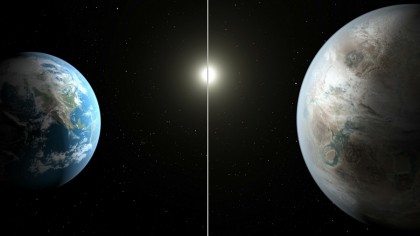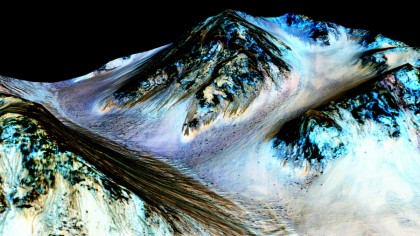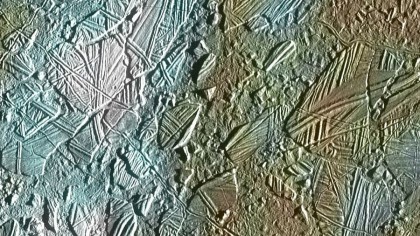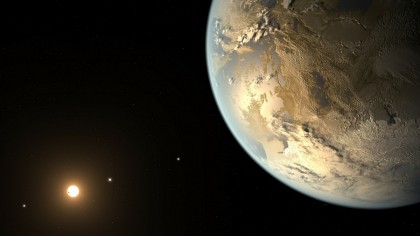Forget Stars Wars aliens – here's where we might find the real ones
It's more likely to be microbes than little green men
Kepler-452b – a Second Earth?

The search for life is all about the 'Goldilocks zone'. Find a planet that's a similar distance from its star as Earth is from the Sun, the theory goes, and it may also have water pooling on its surface. Okay, so that definition may appear to lack imagination and any kind on confidence in the possible variety of alien biology, but we can only go on what we know: life develops in warm, wet conditions.
From the more than 4,000 exoplanets already discovered, only 12 are about the same size as Earth and in the Goldilocks zone, the chief suspect for life being Kepler-452b, the smallest such planet so far discovered. Around 1400 light-years from us, Kepler-452b has a similar distance from and length of orbit around its star, Kepler-452, which is 1.5 billion years older than our Sun. If you're talking about a Second Earth, for now, that means Kepler-452b.
Mars – Panspermia
Is there life on Mars? It's definitely got water. In September geologists found recurring slope lineae – long, dark, damp, salty streaks – on its highlands, evidence that saltwater still flows. The Curiosity rover has found dried-up rivers and pebbles that suggest flowing water, too, and astronomers thinks Mars used to be a lot warmer, and have a much thicker atmosphere, and even oceans.
It's prompted some to theorise that Mars could even be the source of simple microbial life in the Solar System, which came to Earth on meteorites in a process called Panspermia. It's possible – plenty of Martian meteorites have been found on Earth. This is why NASA is so obsessed with Mars.
Mars – forward contamination

There is life on Mars – we put it there. Panspermia works both ways. If Earth is the only source of life – or the only present home of life – then NASA has already accidentally transported extremophile organisms (back?) to Mars on its rovers including Spirit, Opportunity, Viking and Curiosity – the latter of which is banned from going anywhere near water courses.
Maybe the damage is already done – might Mars one day turn green because of our accidental forward contamination? Putting a man on Mars suddenly has serious consequences. From a scientific point of view, there would be no point in ever going back – all you would find would be evidence of Earth-based lifeforms.
However, forward contamination could well be a natural feature of existence in a galaxy. It's also possible that our Solar System both leaves behind a trail of, and busts through a mess of, organic materials and microbes as it moves through its orbit of the centre of the Milky Way, which it does at 828,000 kmh, completing a Galactic Year every 250 million years.
Sign up for breaking news, reviews, opinion, top tech deals, and more.
Europa – an ocean under ice

Europa, the second-closest moon to Jupiter and a bit smaller than our Moon, rocketed up Nasa's to-do list in December 2013 when the Hubble Space Telescope detected water vapour above its south pole. The plumes suggest there's a liquid water ocean on Europa, beneath an icy crust that could be as much as 100km thick. It's suspected that there's more water there than on Earth, but as yet there's no proof.
Europa is considered to be one of the best places to look for extraterrestrial life – it even has both traces of sulphur and an infrared signal similar to that given off by bacteria. Sending a spacecraft to drill into the ice to sample the water for microbial life is impossible with current technology, but since the water vapour is being vented into space it would be possible for an orbiting spacecraft to sample material from deep within the moon without having to drill down into it. Nasa will send a flagship mission to Europa in the mid-2020s.
Kepler-186f – Earth-sized and orbiting an M dwarf star

Go with what you know. The first validated Earth-size planet to orbit a distant star in the habitable zone, exoplanet Kepler-186f, is part of a five-planet star system about 500 light-years from Earth in the constellation of Cygnus. However, Kepler-186f orbits a much smaller star than our Sun, an M dwarf, and in just 130 days. As it does, it receives only a third of the energy the Earth gets; the brightness of its star at high noon is only as bright as our Sun appears about an hour before sunset.
Not ideal? On the contrary… "M dwarfs are the most numerous stars," says Elisa Quintana, research scientist at the SETI Institute at Nasa's Ames Research Center in Moffett Field, California. "The first signs of other life in the galaxy may well come from planets orbiting an M dwarf."
- Jamie Carter is the author of A Stargazing Program for Beginners: A Pocket Field Guide, published this month by Springer.

Jamie is a freelance tech, travel and space journalist based in the UK. He’s been writing regularly for Techradar since it was launched in 2008 and also writes regularly for Forbes, The Telegraph, the South China Morning Post, Sky & Telescope and the Sky At Night magazine as well as other Future titles T3, Digital Camera World, All About Space and Space.com. He also edits two of his own websites, TravGear.com and WhenIsTheNextEclipse.com that reflect his obsession with travel gear and solar eclipse travel. He is the author of A Stargazing Program For Beginners (Springer, 2015),